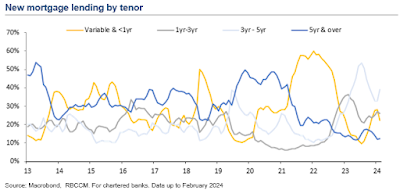**** denotes well-worth reading in full at source (even if excerpted extensively here)
Economic and Market Fare:
- The Fed’s and the market’s forecasts about the future path of the Fed funds rate are almost always wrong.
- The forecasts are very similar, and the Fed has managed to anchor market expectations about where it thinks the Fed funds rate is going.
- The direction of the forecasting mistake is always identical, suggesting that the market is taking its cue about the future path of interest rates from the Fed’s dot plot.
Wafer-thin spreads on corporate debt don’t matter — until they do. There are several potential triggers for risk premia to flare, denting credit portfolios.
Spreads have collapsed across the board, from investment-grade and junk bonds to collateralized loan obligations. The extra yield investors get for owning US high-grade corporate debt instead of government bonds is the lowest in two-and-a-half years.
At less than 90 bps, that’s far below the five-year average of about 120 bps. As a percentage of all-in yield, it’s the least since 2007.
"There's A Lag In The Real Economy... And It's Hitting Now" - Ed Dowd Warns Of "Huge Credit Crisis Coming"
“I don’t think most of the banks understand what is on their balance sheets”
Canada’s Secret Is Out: Growth Is Dead
The biggest story in China in the new millennia has been nation's debt explosion. China's debt-to-GDP ratio is currently estimated at nearly 300% (official numbers), with most of the liabilities accrued in the past 15 years. ......
Vids of the Week:
Who thinks Powell pivoted in DEC?
— Hedgeye (@Hedgeye) May 6, 2024
The pivot was Wednesday says @DiMartinoBooth to @KeithMcCullough.
"Powell said Wednesday, 'I'm going back to not breaking the law.'"#HedgeyeLive
Non-subs: https://t.co/P81zuir6P8
Subs: https://t.co/dgCzt9loJQ pic.twitter.com/72pjYgBsu9
Knausgard: Good decisions are based on experience and experience is based on past bad decisions. This is the basic algorithm of learning. Our mistakes have a didactic value and the bigger they are, the more learning power they contain (the more severe the consequences, the more likely we will internalize their message)
..."Investors produce outstanding long-term results primarily by avoiding dumb decisions, rather than by making brilliant ones."
— Investment Wisdom (@InvestingCanons) May 6, 2024
— Warren Buffett
✍️ Investing isn’t a game of “brilliance”
Rather it’s avoiding:
• Ego
• Greed
• Emotion
• Overconfidence
Avoid mistakes to win.
“Success in investing is not about being right all the time. It’s about minimizing losses and maximizing gains…”
— Investment Wisdom (@InvestingCanons) May 10, 2024
“Don't be afraid to take risks and embrace failure. That’s where the best opportunities lie.”
— Jim Simons
Rest in peace. 🕊️
Charts:
0:
...The Unemployment rate always goes from IGNORE to PANIC in one or two readings. The macro forces took us back to where we left off before COVID as if it never happened. We are close...$SPY #macro #stockmarketcrash $TLT pic.twitter.com/egM9Aakf1O
— Fibonacci Investing⚡️ (@FibonacciInves1) May 6, 2024
...The fact that the 5-year, 5-year forward TIPS-based measure of inflation compensation is so closely linked to spot the oil price, which shouldn't affect inflation 6-10 years out at all, casts suspicion on the validity of these market-based measures https://t.co/1QLNgsFAvE pic.twitter.com/fh0SyB5IkD
— Michael Redmond (@mredmond88) May 9, 2024
For bonds, yields are starting to rise above our “fair value” estimates while term premium is likely biased lower. This shows that cyclically, bonds look reasonably attractive.
— Variant Perception (@VrntPerception) May 9, 2024
(not just) for the ESG crowd:
Geopolitical Fare:
...The New York Times has won a Pulitzer for its “wide ranging and revelatory coverage” of Oct. 7th and Israel's ensuing mass murder campaign. A top journalism prize for laundering Israeli gov't lies and whitewashing its atrocities. What a joke. https://t.co/2vnbFm0hRW
— Aaron Maté (@aaronjmate) May 6, 2024
Stop giving out Pulitzer Prizes until someone tells the real story of Jeff Epstein.
— Matt Stoller (@matthewstoller) May 7, 2024
Sci Fare:
Pics of the Week:



















No comments:
Post a Comment